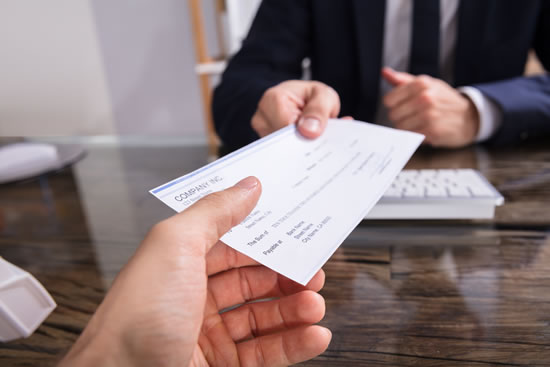If you’re receiving a cashier’s check, you might think it’s a guaranteed form of payment. However, cashier’s check fraud is a common scam that can leave you with a worthless piece of paper and out of your hard-earned money. Knowing how to spot a fake cashier’s check can save you from falling victim to this type of scam.
- Understanding Cashier’s Checks
- Look for Security Features
- Check for a Watermark
- Examine the Check for Signs of Tampering
- Verify the Check with the Issuing Bank
- Be Wary of Overpayment Scams
- How to Verify a Cashier’s Check
- 1. Contact the Issuing Bank
- 2. Speak with Bank Employees
- 3. Visit a Local Branch
- 4. Look for Signs of Forgery
- Potential Consequences of Depositing Fake Checks
- Reporting a Cashier’s Check Scam
One of the first things to look for when examining a cashier’s check is the watermark. A real cashier’s check will have a watermark that is visible when held up to the light. If the watermark is missing or looks blurry, it could be a sign that the check is fake. Additionally, you should examine the check for any signs of alteration or tampering. Look for any erasures, smudges, or other signs that the check has been changed in any way.
Another important factor to consider is the issuing bank. Make sure the bank listed on the check is a real bank and not a fake one. You can verify the bank’s information by contacting them directly or visiting their website. Additionally, be wary of any checks that have an unusually high dollar amount or that come from someone you don’t know. These could be red flags that the check is fake and an attempt to scam you.
Understanding Cashier’s Checks
When it comes to making large transactions, cashier’s checks are often used as a secure payment method. A cashier’s check is a check that is issued directly by a bank, making it a more reliable payment method than a personal check.
When you purchase a cashier’s check, you pay the bank the full amount of the check plus a fee. The bank then issues the check, which is drawn on the bank’s own funds, not on the funds of an individual account holder. This means that the funds are guaranteed, and the check will not bounce.
Cashier’s checks are often used for large transactions, such as purchasing a home, a car, or other expensive items. They are also commonly used for transactions with people you don’t know, such as when buying or selling items online.
It’s important to remember that while cashier’s checks are secure, they can still be subject to fraud. Scammers often create fake cashier’s checks, which look very similar to real ones. These fake checks can be used to steal money from unsuspecting victims.
To avoid falling victim to a cashier’s check scam, it’s important to understand how real cashier’s checks work and to know how to spot a fake one.
Recognizing a Fake Cashier’s Check
Cashier’s checks are often considered a safe and secure method of payment because they are issued by banks and are guaranteed funds. However, fake cashier’s checks are becoming increasingly common, and it’s important to know how to spot them. Here are some tips to help you recognize a fake cashier’s check:
Look for Security Features
One of the most effective ways to spot a fake cashier’s check is to look for security features. Most legitimate cashier’s checks have several security features, such as watermarks, holograms, and special paper. These features are designed to make it difficult for counterfeiters to replicate the check.
Check for a Watermark
One of the most common security features on a cashier’s check is a watermark. A watermark is a design or image that is embedded into the paper during the manufacturing process. When you hold the check up to the light, you should be able to see the watermark. If the check doesn’t have a watermark, or if the watermark looks blurry or faint, it could be a fake.
Examine the Check for Signs of Tampering
Another way to spot a fake cashier’s check is to examine the check for signs of tampering. Check to see if the check has been altered in any way. Look for any erasures, smudges, or other marks that could indicate that the check has been tampered with.
Verify the Check with the Issuing Bank
If you’re still not sure if a cashier’s check is legitimate, you can always verify it with the issuing bank. Call the bank and ask them to verify the check. They will be able to tell you if the check is real or fake.
Be Wary of Overpayment Scams
One common scam involving fake cashier’s checks is the overpayment scam. In this scam, a buyer will send you a cashier’s check for more than the amount you’re asking for. They will then ask you to deposit the check and send them the difference. This is a red flag and could be a sign of a fake cashier’s check.
By following these tips, you can help protect yourself from fake cashier’s checks and other types of check fraud. Remember, if you’re ever unsure about a cashier’s check, it’s always better to be safe than sorry.
How to Verify a Cashier’s Check
When you receive a cashier’s check, it’s important to verify that it’s legitimate before depositing or cashing it. Here are some steps you can take to verify a cashier’s check:
1. Contact the Issuing Bank
The first step to verify a cashier’s check is to contact the issuing bank. You can find the bank’s name and contact information on the check itself. Call the bank’s customer service number and ask to speak with a representative who can help you verify the check.
2. Speak with Bank Employees
When you call the bank, make sure to ask if the check is legitimate. You can also ask the bank employee to confirm that the check is valid and that the funds are available. If the bank employee can’t verify the check over the phone, ask if you can visit a local branch to have the check verified in person.
3. Visit a Local Branch
If you’re still unsure about the validity of the check, visit a local branch of the issuing bank. Bring the check with you and ask to speak with a bank employee who can help you verify the check. The bank employee may ask to see identification and may need to make a copy of the check before verifying it.
4. Look for Signs of Forgery
Even if the check appears to be legitimate, it’s still a good idea to look for signs of forgery. Some signs of forgery include:
- Misspellings or incorrect information on the check
- Alterations to the check, such as erasures or white-out
- Different fonts or colors on the check
- No watermarks or security features on the check
If you notice any of these signs, do not deposit or cash the check. Instead, contact the issuing bank and report the suspected forgery.
By following these steps, you can help protect yourself from cashier’s check fraud and ensure that the funds are available before depositing or cashing the check.
Potential Consequences of Depositing Fake Checks
Depositing a fake cashier’s check can have serious consequences. Quite similar to the dangers of eChecks. Here are some of the potential outcomes that you should be aware of:
Overdrawing Your Account
If you deposit a fake check, it could bounce, leaving you with a negative balance in your bank account. This can result in overdraft fees, which can be costly and add up quickly.
Losing Money
In addition to overdraft fees, you could also lose the money that you deposited. If the bank determines that the check is fake, they may reverse the deposit and take the money out of your account. This means that you could be out the money that you thought you had.
Legal Consequences
Depositing a fake check is illegal, and you could face legal consequences if you do so. This could include fines, penalties, and even jail time in some cases.
Damaged Credit
If you overdraft your account or fail to pay back the money that you owe to the bank, this could negatively impact your credit score. This could make it harder for you to get approved for loans, credit cards, and other financial products in the future.
Identity Theft
In some cases, fake checks may be part of a larger scam that is designed to steal your personal information. If you deposit a fake check and provide personal information to the scammer, they could use this information to steal your identity and commit fraud.
To avoid these potential consequences, it’s important to be vigilant when it comes to spotting fake checks. If you’re unsure whether a check is legitimate, it’s always best to verify it with the bank before depositing it.
Reporting a Cashier’s Check Scam
If you suspect that you have been the victim of a cashier’s check scam, it’s important to report it to the appropriate authorities as soon as possible. Reporting the scam can help prevent others from falling victim to the same scheme and may also help you recover any lost funds.
Here are some steps you can take to report a cashier’s check scam:
- Contact your bank immediately: If you have deposited a fraudulent cashier’s check, contact your bank right away. They can help you stop any payments or transfers related to the check and may also be able to help you recover any lost funds.
- File a complaint with the Police: The policeis responsible for investigating and prosecuting scams that affect consumers.
- Contact your state attorney general: Your state attorney general’s office may also be able to help you report the scam and recover any lost funds. They can also provide you with information about other resources that may be available to you.
- File a complaint with the Better Business Bureau (BBB): The BBB is a nonprofit organization that helps consumers find businesses they can trust. They also track scams and can provide information about how to avoid them.
Remember, reporting a cashier’s check scam can help protect others from falling victim to the same scheme. Be sure to keep records of any communications you have with the scammers and any documentation related to the scam. This information can be helpful to law enforcement agencies as they investigate the scam and work to bring the scammers to justice.
WATCH TOP VIDEOS FROM NIGERIAN TRIBUNE TV
- Let’s Talk About SELF-AWARENESS
- Is Your Confidence Mistaken for Pride? Let’s talk about it
- Is Etiquette About Perfection…Or Just Not Being Rude?
- Top Psychologist Reveal 3 Signs You’re Struggling With Imposter Syndrome
- Do You Pick Up Work-Related Calls at Midnight or Never? Let’s Talk About Boundaries







